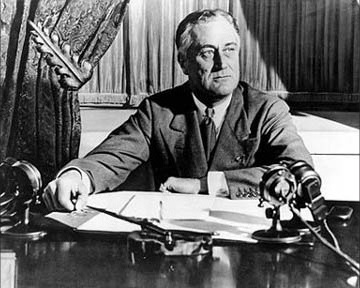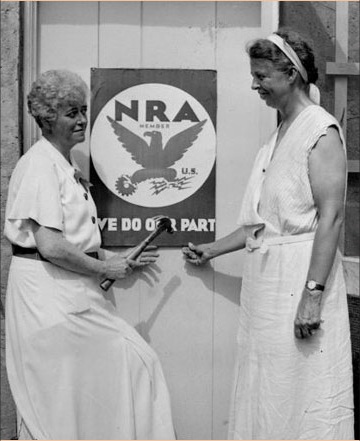Publisher's note: We believe the subject of history makes people (i.e., American people) smarter, so in our quest to educate others, we will provide excerpts from the North Carolina History Project, an online publication of the John Locke Foundation. This forty-third installment, was originally posted in the North Carolina History Project.
Established by the National Industrial Recovery Act (NIRA) in 1933, the National Recovery Administration (NRA) was one of two early New Deal programs intended to revive U.S. industry after years of contraction. While designed to stabilize commerce, the NRA was unsuccessful, particularly in North Carolina.
The NIRA represented the
President Franklin D. Roosevelt
culmination of President Franklin D. Roosevelt's first "Hundred Days" in office. With the American economy failing, Roosevelt had immense political capital in the Hundred Days. He used this political capital to sign a multitude of bills into law: most were intended to stimulate the U.S. economy and initiate recovery. Some, such as the NIRA and the Civilian Conservation Corps Reforestation Relief Act, created new programs and agencies; others, such as the Federal Emergency Relief Act, spent Federal funds so that the government expenditures might increase aggregate demand in the United States.
Of all of the bills passed during the Hundred Days, the NIRA, which created the NRA and the Public Works Administration (PWA), had the farthest-reaching effects. Although the PWA and its many projects became emblematic of the New Deal, the NRA was given a wider mandate. Under the NIRA, the NRA was charged with restarting U.S. industry by stabilizing it. This stabilization was to be effected by the promulgation of "codes of fair competition," which would stipulate fair wages and commodity prices. Public-private committees of NRA technocrats and business leaders would devise these codes of fair competition. The NRA's proponents claimed that the codes would serve the interests of business, worker, and consumer alike, while generating a more coordinated and cooperative economy.
Insofar as each
First Lady Eleanor Franklin D. Roosevelt
industry established a code of fair competition, the NRA functioned as designed. Industries as diverse as the bituminous coal industry, the book publishing industry, and the investment banking industry each developed codes of fair competition. These codes, however, failed to help American industry. They never sufficiently served the interests of consumer, worker, or small business owner, and many businesses, particularly small ones, violated the codes.
The failures of the NRA stemmed partially from President Roosevelt's appointment of Hugh Johnson--a respected businessman and retired brigadier general--to lead the bureau. Johnson was responsible for staffing the committees that would draft the codes of fair competition. Because of his background, most of his contacts were executives of large businesses. Consequently, business leaders preponderated among codemaking authorities, and their interests had primacy in the codemaking process.
Labor representatives were rare in the codemaking authorities--less than ten percent of the authorities had labor representatives. Consumer representation was even rarer, with less than two percent of the authorities ever having a consumer representative. As historian David Ciepley and others have argued, the NRA partially cartelized American industry and obliterated competition in many industries in the United States. The anti-competitive effect of the NRA was exacerbated by the extraordinary ambit of its power: approximately 95 percent of the U.S. industrial workforce was regulated by the codes of fair competition.
In North Carolina, the NRA profoundly affected the state's tobacco, textile, and furniture industries. The state's tobacco industry was more insulated than the other two from the reach of the NRA. The Depression had not caused a significant slowdown for the tobacco industry. After the passage of the NIRA, the tobacco industry first resisted the NRA's demands that it create a code of fair competition, but industry leaders acquiesced in February 1935. The primary effect of the tobacco code in North Carolina was a substantial wage increase for tobacco workers. Though this wage increase might appear to have been a benefit of the tobacco code, it in fact harmed many tobacco workers. Tobacco companies could not afford to pay such high wages to large numbers of unskilled workers; consequently, they laid off unskilled workers in order to purchase machines and hire skilled workers to operate them. Because North Carolina's unskilled workforce was predominantly African-American and its skilled workforce largely white, the tobacco code did immeasurable economic harm to blacks in North Carolina.
The NRA also influenced North Carolina's third-largest industry: furniture. The industry's code of fair competition stipulated a minimum wage and a forty-hour workweek. These regulations limited the manufacture of furniture and thereby resulted in a decrease in supply and an inflation in price. While neither North Carolina furniture workers nor furniture company owners were significantly harmed by the NRA, the increase in the price of furniture did not benefit the American consumer.
The effect of the NRA on the textile industry in North Carolina was almost entirely bad. Textile producers and workers suffered under the textile code of fair competition, the first to be created (a feat lauded by President Roosevelt and Hugh Johnson). The textile industry initially seemed to begin a recovery after the implementation of the textile code. The industry's problem with excess supply, however, proved intractable, and labor disputes began to mount in North Carolina. On September 3, 1934, these disputes culminated in a general strike in the textile industry. The strike, which lasted three weeks, failed to improve wages or working conditions in the industry. While textile workers experienced setbacks in 1934, textile producers did not flourish. Business and worker alike suffered under the textile code.
The end of the NRA originated in the noncompliance of a small Kosher poultry producer--the Scehcter Poultry Corporation--with the poultry code. The Justice Department accused the small company of pricing its chickens too competitively. The Schechter family fought the Justice Department, and the case reached the Supreme Court. On May 27, 1935, the NRA ceased to exist. In Schechter Poultry Corporation v. United States, the U.S. Supreme Court ruled that the NIRA unconstitutionally regulated intrastate commerce (as opposed to interstate commerce, which Congress is authorized to regulate under the Constitution) by establishing a bureau, the NRA, to coordinate industry.
Sources:
Douglas Carl Abrams, Conservative Constraints: North Carolina and the New Deal (Jackson, Mississippi, 1992); David Ciepley, Liberalism in the Shadow of Totalitarianism (Cambridge, Massachusetts; 2006); John Steele Gordon, An Empire of Wealth (New York, 2004); Mancur Olson, The Rise and Decline of Nations (New Haven 1984); Schechter Poultry Corporation et al. v. United States, 295 U.S. 495 (U.S. Supreme Court, 1935), http://supct.law.cornell.edu/supct/html/historics/USSC_CR_0295_0495_ZO.html (accessed February 2009); and Amity Shlaes, The Forgotten Man: A New History of the Great Depression (New York, 2007).
























